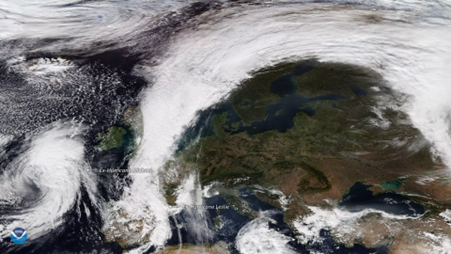Storms & Flooding
Storm Lesley
 Europe
Europe
 CAT 2
CAT 2
 12 October, 2024
12 October, 2024 Storm Lesley, a powerful and long-lived weather system, hit Spain and neighboring countries in October 2024. Originating as a tropical storm in the Atlantic, Lesley made its way across the Iberian Peninsula, bringing widespread damage, high winds, and torrential rains. Lesley is notable for being one of the few Atlantic tropical storms to retain its intensity upon reaching Europe, highlighting its unusual trajectory and strength.
Path and Timeline
- 2-6 October: Lesley formed in the Atlantic and intensified to a Category 2 hurricane, reaching winds up to 105 mph.
- 7 October: The storm began moving eastward, undergoing extratropical transition as it approached the Iberian Peninsula.
- 8-9 October: Southwestern Spain (Huelva, Seville, and Cádiz) began to experience heavy rain and strong winds as the remnants of Lesley approached.
- 10-11 October: The storm peaked in intensity, with over 200 mm of rain recorded in mountainous areas. The southwest quadrant faced severe flooding, mudslides, and wind damage.
- 12-13 October: Lesley entered the Iberian Peninsula, with the storm’s center affecting western Spain and Portugal.
- 14-15 October: Heavy rains and wind gusts exceeding 120 km/h lashed Galicia and northern Spain, triggering red weather alerts in multiple regions. The Balearic Islands and Catalonia also faced significant disruptions, including localized flooding.
- 16 October: As Lesley moved eastward, it weakened but continued to bring rain and wind through eastern Spain, before heading towards southern France.
Impact on Spain
Northwest Spain:
Regions like Galicia and Asturias bore the brunt of Lesley’s early impact. Severe flooding and high winds disrupted transportation, damaged infrastructure, and led to power outages affecting tens of thousands of residents. In some coastal areas, waves reached over 10 meters, posing significant risks to coastal towns.
Central Spain:
Central Spain saw less rain but strong winds that caused widespread damage to buildings, trees, and vehicles. Madrid, in particular, experienced gusts that disrupted public transport and resulted in hundreds of emergency calls for assistance.
Southern and Eastern Spain:
Though the intensity of the storm reduced as it moved southward, regions such as Andalusia and Valencia were affected by strong wind gusts and sporadic thunderstorms. Localized flooding caused temporary road closures and further disrupted daily life.
Key Areas Affected:
- Galicia and Asturias: Record rainfall and strong coastal winds led to significant flooding and infrastructure damage.
- Madrid: High winds caused transport delays and urban disruption.
- Valencia and Balearic Islands: Faced high wind speeds and localized flooding.
- Andalusia:
- Cádiz and Málaga experienced flash floods, with emergency services responding to multiple incidents of stranded vehicles and flooded homes. Ports in Algeciras were temporarily closed due to high winds and dangerous sea conditions. Coastal roads suffered disruptions as waves reached several meters in height.
- Seville and Granada, while not as directly affected as the coastal regions, these inland areas saw heavy rainfall that contributed to localized flooding and power outages in rural communities.
Response and Warnings
Spain’s Agencia Estatal de Meteorología (AEMET) issued red and orange alerts across multiple regions, warning residents of strong winds, potential flooding, and dangerous sea conditions. Emergency services were on high alert, with evacuations carried out in areas at highest risk of floods.
By October 16, authorities began to assess the damage, but the storm’s toll was already significant. Dozens of flights were cancelled, ferry services suspended, and agricultural damage in rural areas was widespread. AEMET continues to monitor the aftermath and advises caution in regions with lingering flood risks.
For more details and updates on local warnings, visit AEMET’s official website.
Storm Lesley left a mark on Spain, with its powerful winds and rains severely impacting daily life across all regions. With a history of storm damage in recent years, Spain’s emergency systems responded swiftly, though the full economic impact is still being assessed as local authorities continue to monitor areas at risk of residual flooding as efforts to recover begin.
National Environmental Satellite, Data and Information Service
Business Interruption Coverage Issues
It should be anticipated that the insurance industry will see significant claims presented in industries such as:
Agriculture: with obvious damage to crops and livestock, but also in respect to the processing plants that will have been affected by power outages and transportation disruption.
Tourism & Hospitality: widespread damage and transportation disruption will lead to a vast number of event cancellations.
Manufacturing: damage and destruction of facilities and structures, as well as the vast disruption to the supply chain and transportation links.
Early involvement of the appropriate experts can help with the need for any mitigation efforts.
MDD has considerable expertise in dealing with these types of claims and the complexities that may occur. Experts like those of us at MDD will stress the need for proper audit protocols, controlling and sorting of costs and accounting for any potential saved expenses.
MDD has Spanish-speaking professionals ready and available to assist, including Jaime Muñoz (Director of the Madrid office), Markus Heiss (German, English and Spanish), Marcelo Fazio (English, German, Italian, Spanish), Ed Secchi (English, Italian, Spanish, Portuguese), Sam Dorie (English, French and Spanish), Karina Olague (English and Spanish), Sergio Londoño (English and Spanish), Adria Fochs (English and Spanish).









